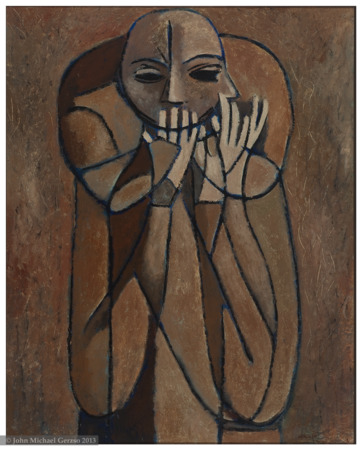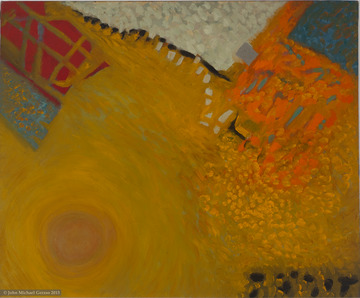How Do I Find Out if a Gunther Gerzso Painting is Authentic.


Feb. 8, 2022
There are several ways to find out if a Gunther Gerzso work of art is authentic. The best way is to posses a documented history of the owners (provenance) of the work since the time it was released by Gerzso, that is, by selling, giving, bestowing or by a will. If the work was auctioned by a reputable house such as Christie's, Sotheby's or equivalent, the probability that the work is authentic is greater because they research it before they put in sale.
If you have some or no documentation, then galleries or auction houses which sold the work might have records of the provenance. For paintings or prints, you can send me an image of the front and back of the work, the title, size and medium, and I can determine if I have a record of it (sometimes fees apply). The fact that the authentic works exists does not mean that it is the same one you have, which could be a copy, reproduction or worse, a fake.
Lastly, consult publications on Gerzso's work to see if what you have appears in any of them.
Two Examples of Unusual Gerzsos
As far as I know, "Silencio" is the only painting of that type. Sometimes it is considered in the Cubist style. However, the painting is well known, has appeared in several exhibitions and in the catalog of the Gerzso restrospective by Diana DuPont, et al. It is signed and dated and has several exhibition registration/inventory tags on the back.
The untitled painting was found in his studio, appears to be made of typical materials used by Gerzso. At this time, no documents of this painting have been located in his archive. It is possible that it is authentic, but more research needs to be done.
Some Advice Before You Obtain a Work (Painting, Sculpture, Print etc.)
I am frequently contacted to determine the authenticity of a work by Gunther Gerzso. In many cases there is a lack of understanding on how to know if what they have is real or not.
For legal and practical reasons, I do not authenticate any work, but I can provide some tips:
Even though there are laws to protect consumers, the best approach is “buyer beware”. Do your homework as much as you can.
However, if you found a work, or received it as a gift or inheritance and want to sell it, do as much as you can to determine if it is authentic.
The Best Way to Know.
The best way is to locate or obtain the complete paper trail of the work by Gunther Gerzso (GG)since the time it was released (sold or otherwise). This is known in the art world as the provenance of the work.
This should (hopefully) include:
1-the invoice of the first sale by GG or one of his galleries. It should include a complete description of the work, eg title, year, medium, size etc.
2-a photo (bw or color) at the time it was produced including the frame if there was one.
3-a list of all the owners and galleries in addition to the first one. If the work was auctioned, list the auction houses, the more prestigious the better.
4-a list of all/any exhibitions in which the work has appeared, along with the corresponding catalogs. These exhibitions should be of good to excellent museums, eg Museo de Arte Moderno, Bellas Artes, in Mexico, and Denver Art Museum, LA County Museum etc, in the US.
5-sometimes an owner took the work to GG, and he signed a letter stating that it was his. Include this one also.
6-If the work has been in important exhibitions, include a photo of the back which may have tags or labels of the museum.
Ways to Obtain Provenance Documents.
1-Contact me at this web site or a gallery to determine of the work was actually created at all. At this time there is no catalog of his complete works. Either me or a gallery to consult our files. However if we state that a work does have a record, this is NOT THE SAME AS CERTIFYING THE WORK IN QUESTION AS BEING AUTHENTIC. IT ONLY MEANS THAT THERE IS A RECORD IN A GALLERY OR IN GUNTHER GERZSO’S ARCHIVE.
2-Sometimes a gallery can provide the list of owners and/or exhibitions.
3-As a complement to this basic documents, consult as many books on Gunther Gerzso or exhibition catalogs in which his works appear.
Trust and if You Can, Verify.
Even if you have a good set of provenance documents, there are other factors to consider. For example:
1-Are you obtaining the work from a trustworthy person, gallery or institution? Or is the person trustworthy, well-intentioned but misinformed. That is, is the work could be a copy.
2-If you can, get an expert at a gallery or museum to look at the work which could include forensic analysis to determine the authenticity of the materials.
Can a Work Be Authentic But Have No Provenance Documents?
Yes. From 1930 to 1960, GG was known to give or sell paintings to relatives and friends without recording anything. His and/or his wife’s record keeping did not become methodical until the late 1950’s.
In one case, GG gave one of his paintings to a person in the 1950’s (no record), who moved to another country taking the work. It remained in the person’s family for 50 years until it was put on the market. It was never lent to a museum or published.
GG has done other paintings over the years as exercises or explorations. He did not intend them to be sold or shown. Sometimes he gave them to friends such as the “Blue Cat”. Its only provenance is the friend who was a reputable collector.
Authentic vs Semi-Authentic vs Copy vs Reproduction vs Forgery.
1-An authentic work by Gunther Gerzso (or in general any other artist) is one that is created (drawn, painted or sculpted)by him with or without collaborators based on his idea or design and signed and dated (year) by him. He owns the intellectual property (copyright).In the case of prints and some sculptures, an edition can include between 20 and 50 items each one signed, numbered and dated. The point being that each work is unique by virtue of the GG signature. A work can be created and finished by him but have no value if it was not signed and dated by him.
It is important to note that a work of art signed is considered an asset which can appreciate/depreciate in value just like a piece of real estate or a stock.
2-A semi-authentic work is one created by GG but not signed. In some situations, it is important to know that GG created the work despite its having less commercial value than an original.
3- Copies. Note: Each country has laws regarding copies, reproductions and forgeries. You should consult your lawyers for advice on these matters.
As far as I understand, it is legal to make a copy (drawing, painting & sculpting) of a work by GG. Art students and hobbyists do this to learn about painting and GG. The size of the copy should be (must be) different than the original. Probably the signature should not be copied.
4- Reproductions are usually made by means of photography and printing and appear in books, magazines and posters. Their production is regulated by copyright laws, a topic too extensive to cover here.
5- Forgery is an exact copy of an original in terms of size, technique, frame and signature which is being presented, transacted and/or sold as THE original. In many counties, this activity illegal.